In this column, we share several new selections of poetry that provide opportunities for interdisciplinary connections. Poetry functions as both a format and a genre in these books. Novels in verse with inviting stories are included alongside poetry collections, some of which have an informational focus. There’s something for everyone when reading and sharing poetry.
Ages 4–8
Bully on the Bus. Kathryn Apel. 2018. Kane Miller.
 Seven-year-old Leroy loves reading, playing, and being one of Mrs. Wilson’s Superkids. He hates riding the bus to school because DJ, a high school student who says school is “for dummies,” physically and verbally accosts him. Each school day Leroy worries, “What will the bully do today?” and doesn’t understand why no one intervenes. Neither the elderly bus driver nor his older sister, Ruby, a fifth grader, can stop DJ’s bullying. Despite the bully's attempts to silence him with threats of worse to come, Leroy finds the courage to confide his feelings to his parents and teacher. Remembering their advice and armed with a secret weapon, he’s prepared to stand up to the bully on the bus. Reading this short chapter book in verse is a good opener for discussion of the issue of bullying.
Seven-year-old Leroy loves reading, playing, and being one of Mrs. Wilson’s Superkids. He hates riding the bus to school because DJ, a high school student who says school is “for dummies,” physically and verbally accosts him. Each school day Leroy worries, “What will the bully do today?” and doesn’t understand why no one intervenes. Neither the elderly bus driver nor his older sister, Ruby, a fifth grader, can stop DJ’s bullying. Despite the bully's attempts to silence him with threats of worse to come, Leroy finds the courage to confide his feelings to his parents and teacher. Remembering their advice and armed with a secret weapon, he’s prepared to stand up to the bully on the bus. Reading this short chapter book in verse is a good opener for discussion of the issue of bullying.
—MN
A Round of Robins. Katie Hesterman. Ill. Sergio Ruzzier. 2018. Nancy Paulsen/Penguin.
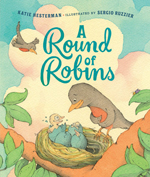 Katie Hesterman offers young readers 16 delightful poems about a family of robins. Mama Robin is the “architect” who collects materials to build a nest. “It’s guaranteed a perfect fit / So all she has to do is sit,” waiting for “Four little ones all set to hatch— / An up-and-coming birdie batch.” The poems important milestones: the four eggs hatch, the fledglings grow, they learn to fly and find worms, and the siblings finally venture out on their own. Mama now builds a new nest and lays four more eggs. Sergio Ruzzier’s lighthearted pen-and-ink and watercolor illustrations give the robins anthropomorphic facial expressions. This debut collection of poems about the robin’s life cycle will soar off the shelves.
Katie Hesterman offers young readers 16 delightful poems about a family of robins. Mama Robin is the “architect” who collects materials to build a nest. “It’s guaranteed a perfect fit / So all she has to do is sit,” waiting for “Four little ones all set to hatch— / An up-and-coming birdie batch.” The poems important milestones: the four eggs hatch, the fledglings grow, they learn to fly and find worms, and the siblings finally venture out on their own. Mama now builds a new nest and lays four more eggs. Sergio Ruzzier’s lighthearted pen-and-ink and watercolor illustrations give the robins anthropomorphic facial expressions. This debut collection of poems about the robin’s life cycle will soar off the shelves.
—MN
Vivid: Poems and Notes About Color. Julie Paschkis. 2018. Godwin/Henry Holt.
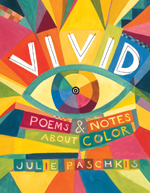 Julie Paschkis playfully pairs paintings with poems and informational notes to explore color. Spreads pay tribute to yellow, orange, red, pink, purple, indigo, blue, green, brown, white, and black, ending with the poem “Rainbow.” Paschkis’ vibrant gouache paintings express the many depths and shades of color and complement her frolicsome poems, which are rich with descriptive language. “Loudly, rowdy / daffodils yell hello. / Hot yellow.” Her verses also employ wordplay to reveal associated emotions. “Oh, what did I do? / Blue-hoo, / Blue-hoo!” Text boxes present notes on the origins and meanings of color names and fascinating tidbits about the colors. An author’s note provides basic information on the science of color and the perception of colors by humans and different animals.
Julie Paschkis playfully pairs paintings with poems and informational notes to explore color. Spreads pay tribute to yellow, orange, red, pink, purple, indigo, blue, green, brown, white, and black, ending with the poem “Rainbow.” Paschkis’ vibrant gouache paintings express the many depths and shades of color and complement her frolicsome poems, which are rich with descriptive language. “Loudly, rowdy / daffodils yell hello. / Hot yellow.” Her verses also employ wordplay to reveal associated emotions. “Oh, what did I do? / Blue-hoo, / Blue-hoo!” Text boxes present notes on the origins and meanings of color names and fascinating tidbits about the colors. An author’s note provides basic information on the science of color and the perception of colors by humans and different animals.
—SH
Ages 9–11
Can I Touch Your Hair?: Poems of Race, Mistakes, and Friendship. Irene Latham & Charles Waters. Ill. Sean Qualls & Selina Alko. 2018. Carolrhoda/Lerner.
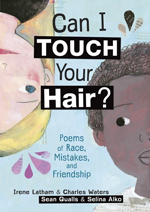 Irene Latham and Charles Waters collaborate on a series of thought-provoking,dueling poems about race and human connection. The poems are written from the perspectives of two fifth graders, Irene (who is white) and Charles (who is black). Within the first poem set, the reader discovers their reluctance to work together when they are assigned to be partners on a poetry writing project. However, as the poems progress, they begin to realize their similar interests and to understand their differences, and a special bond begins to form. “Sometimes we say the wrong thing, sometimes we misunderstand. / Now we listen, we ask questions. We are so much more than black and white!” The expressive illustrations, rendered in acrylic paint, colored pencil, and collage, reinforce the understanding and friendship that come through Irene and Charles’ communication during the project.
Irene Latham and Charles Waters collaborate on a series of thought-provoking,dueling poems about race and human connection. The poems are written from the perspectives of two fifth graders, Irene (who is white) and Charles (who is black). Within the first poem set, the reader discovers their reluctance to work together when they are assigned to be partners on a poetry writing project. However, as the poems progress, they begin to realize their similar interests and to understand their differences, and a special bond begins to form. “Sometimes we say the wrong thing, sometimes we misunderstand. / Now we listen, we ask questions. We are so much more than black and white!” The expressive illustrations, rendered in acrylic paint, colored pencil, and collage, reinforce the understanding and friendship that come through Irene and Charles’ communication during the project.
—SH
Leaf Litter Critters. Leslie Bulion. Ill. Robert Meganck. 2018. Peachtree.
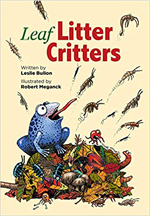 Leslie Bulion presents 19 clever poems about some of the microscopic critters and organisms at work in leaf litter ecosystems. Did you know that rotifers are the “smallest multicellular animals” or that nematodes are “food for soil predators”? Each spread includes a lively poem accompanied by informative and accessible “Science Notes” and colorful, comic-style illustrations about the decomposers and recyclers that comprise the world’s “brown food web.” The extensive back matter includes a glossary, poetry notes about the different forms (free verse, cinquain, clerihew, and more) that Bulion uses, hands on “investigator” activities, resources for further investigation, and a final illustration that shows the relative size of the leaf litter critters to the head of a pin. Reading aloud this collection of interest-catching poems and science notes is the perfect way to spark further inquiries about “leaf litter critters” and to make interdisciplinary connections between science and poetry in the classroom.
Leslie Bulion presents 19 clever poems about some of the microscopic critters and organisms at work in leaf litter ecosystems. Did you know that rotifers are the “smallest multicellular animals” or that nematodes are “food for soil predators”? Each spread includes a lively poem accompanied by informative and accessible “Science Notes” and colorful, comic-style illustrations about the decomposers and recyclers that comprise the world’s “brown food web.” The extensive back matter includes a glossary, poetry notes about the different forms (free verse, cinquain, clerihew, and more) that Bulion uses, hands on “investigator” activities, resources for further investigation, and a final illustration that shows the relative size of the leaf litter critters to the head of a pin. Reading aloud this collection of interest-catching poems and science notes is the perfect way to spark further inquiries about “leaf litter critters” and to make interdisciplinary connections between science and poetry in the classroom.
—MN
Shaking Things Up: 14 Young Women Who Changed the World. Susan Hood. 2018. HarperCollins.
 Susan Hood plays with free verse, rhyme, font variety, text alignment, and repetition in her poetry collection about 14 young female “movers and shakers.” Each inspirational figure is featured on a spread. Titles such as “Secret Agent Sisters” (about Jacqueline and Eileen Nearne) and “Books, Not Bullets” (about Malala Yousafzai) will ignite curiosity and draw readers in. Poems (written in various formats from narrative poetry, to acrostic, to shape poems) and brief biographical notes are paired with full-page illustrations featuring the young women by different female illustrators and notable quotes. Back matter includes an author’s note as well as additional information and resources about the 14 women included in the text.
Susan Hood plays with free verse, rhyme, font variety, text alignment, and repetition in her poetry collection about 14 young female “movers and shakers.” Each inspirational figure is featured on a spread. Titles such as “Secret Agent Sisters” (about Jacqueline and Eileen Nearne) and “Books, Not Bullets” (about Malala Yousafzai) will ignite curiosity and draw readers in. Poems (written in various formats from narrative poetry, to acrostic, to shape poems) and brief biographical notes are paired with full-page illustrations featuring the young women by different female illustrators and notable quotes. Back matter includes an author’s note as well as additional information and resources about the 14 women included in the text.
—SH
Thirteen Ways of Looking at a Black Boy. Tony Medina. 2018. Penny Candy Books.
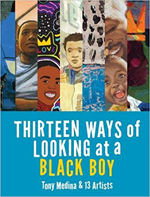 The poems in this collection are accompanied by illustrations by 13 different artists, including Euka Holmes, Floyd Cooper, Javaka Steptoe, and R. Gregory Christie. Touching on themes such as family, religion, community, poverty, and pride, the intent of the book is to affirm and empower African American youth. The “thirteen ways of looking at a black boy” are explored in tanka poems, which work both as singular poems and as a collective piece. Back matter includes brief biographies of poet Tony Medina and each illustrator and information about the inspiration for the title, tanka, and setting (Anacostia, the historically black neighborhood of Washington, DC).
The poems in this collection are accompanied by illustrations by 13 different artists, including Euka Holmes, Floyd Cooper, Javaka Steptoe, and R. Gregory Christie. Touching on themes such as family, religion, community, poverty, and pride, the intent of the book is to affirm and empower African American youth. The “thirteen ways of looking at a black boy” are explored in tanka poems, which work both as singular poems and as a collective piece. Back matter includes brief biographies of poet Tony Medina and each illustrator and information about the inspiration for the title, tanka, and setting (Anacostia, the historically black neighborhood of Washington, DC).
—LC
Ages 12–14
Missing Mike. Shari Green. 2018. Pajama Press.
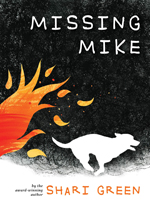 Set in Canada, this novel in verse tells the story of 11-year-old Cara, whose beloved dog Mike goes missing when the family evacuates due to a wildfire. Cara’s sadness is palpable, and her descriptions of the setting are moving. “Ever since smoke moved in / and draped the world / in gloomy gray / it hasn’t felt like July / even though the heat / and school vacation / said it was.” Cara can’t stop worrying about Mike. Readers learn how Mike came to live with Cara and what her life was like before the wildfire. The heart of this story is whether or not Cara will be reunited with Mike, if he’s survived the wildfire. It’s is also a story about the meaning of home as Cara, who is obsessed with crossword puzzles, reflects on all the different words she learns for home while living through the wildfire. These varied ways of thinking about home are key to Cara and her community’s survival.
Set in Canada, this novel in verse tells the story of 11-year-old Cara, whose beloved dog Mike goes missing when the family evacuates due to a wildfire. Cara’s sadness is palpable, and her descriptions of the setting are moving. “Ever since smoke moved in / and draped the world / in gloomy gray / it hasn’t felt like July / even though the heat / and school vacation / said it was.” Cara can’t stop worrying about Mike. Readers learn how Mike came to live with Cara and what her life was like before the wildfire. The heart of this story is whether or not Cara will be reunited with Mike, if he’s survived the wildfire. It’s is also a story about the meaning of home as Cara, who is obsessed with crossword puzzles, reflects on all the different words she learns for home while living through the wildfire. These varied ways of thinking about home are key to Cara and her community’s survival.
—LC
World Make Way: New Poems Inspired by Art from the Metropolitan Museum. Lee Bennett Hopkins (Ed.). 2018. Abrams.
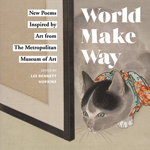 This impressive collection of ekphrastic poems by 18 contemporary children’s poets, inspired by works of art on display at the Metropolitan Museum of Art, is a true celebration of the transformative power of art and words. On each spread, readers will draw inspiration from the poetic interpretation appearing alongside a famous work of art. The synergetic interplay between art and poetry will ignite further reflection and emotional response. The book is introduced with a quote from Leonardo Da Vinci—“Painting is poetry that is seen rather than felt, and poetry is painting that is felt rather than seen”—and an informative foreword by editor Lee Bennett Hopkins. Back matter includes notes about the poets and artists, credits for the poetry and works of art, and an index. Teachers may want to encourage students to further explore writing inspired by art.
This impressive collection of ekphrastic poems by 18 contemporary children’s poets, inspired by works of art on display at the Metropolitan Museum of Art, is a true celebration of the transformative power of art and words. On each spread, readers will draw inspiration from the poetic interpretation appearing alongside a famous work of art. The synergetic interplay between art and poetry will ignite further reflection and emotional response. The book is introduced with a quote from Leonardo Da Vinci—“Painting is poetry that is seen rather than felt, and poetry is painting that is felt rather than seen”—and an informative foreword by editor Lee Bennett Hopkins. Back matter includes notes about the poets and artists, credits for the poetry and works of art, and an index. Teachers may want to encourage students to further explore writing inspired by art.
—MN
Ages 15+
For Every One, Jason Reynolds. 2018. Caitlyn Dlouhy/Atheneum/Simon & Schuster.
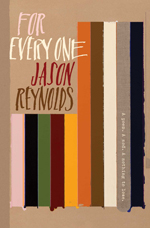 For Every One is a combination poem and letter by Jason Reynolds that speaks directly to young people, more specifically to young dreamers and young writers. “Dreams don’t have timelines, / deadlines, /and aren’t always in / straight lines.” The tone is reflective and conversational, and readers will feel like he is speaking directing to them. The front endpaper includes repeated “To:” and “From:” lines, suggesting readers pass the book along. Typography is manipulated throughout the book; the poems are presented in a font that looks like they have been typewritten while the titles and interludes have more of a hand-lettered look with shaded backgrounds. The book does seem ideal for gift giving at times of great accomplishment such as graduations, but the poems are not nostalgic or overly sentimental. Instead, they are honest and complicated in a way that teenagers will resonate with teenagers.
For Every One is a combination poem and letter by Jason Reynolds that speaks directly to young people, more specifically to young dreamers and young writers. “Dreams don’t have timelines, / deadlines, /and aren’t always in / straight lines.” The tone is reflective and conversational, and readers will feel like he is speaking directing to them. The front endpaper includes repeated “To:” and “From:” lines, suggesting readers pass the book along. Typography is manipulated throughout the book; the poems are presented in a font that looks like they have been typewritten while the titles and interludes have more of a hand-lettered look with shaded backgrounds. The book does seem ideal for gift giving at times of great accomplishment such as graduations, but the poems are not nostalgic or overly sentimental. Instead, they are honest and complicated in a way that teenagers will resonate with teenagers.
—LC
Mary Napoli is an associate professor at Penn State Harrisburg, where she coordinates the Master of Education in Literacy Education program and teaches undergraduate and graduate courses in children’s literature and literacy methods. Lesley Colabucci is an associate professor of Early, Middle, and Exceptional Education at Millersville University of Pennsylvania. She teaches classes in children’s literature at the graduate and undergraduate level. Her research interests include multicultural children’s literature and responses to literature. Skye Hisiro is an elementary classroom teacher in Harrisburg, Pennsylvania, and a recent graduate from Penn State Harrisburg’s Master of Education in Literacy Education program.
These reviews are submitted by members of the International Literacy Association's Children's Literature and Reading Special Interest Group (CL/R SIG) and are published weekly on Literacy Daily.